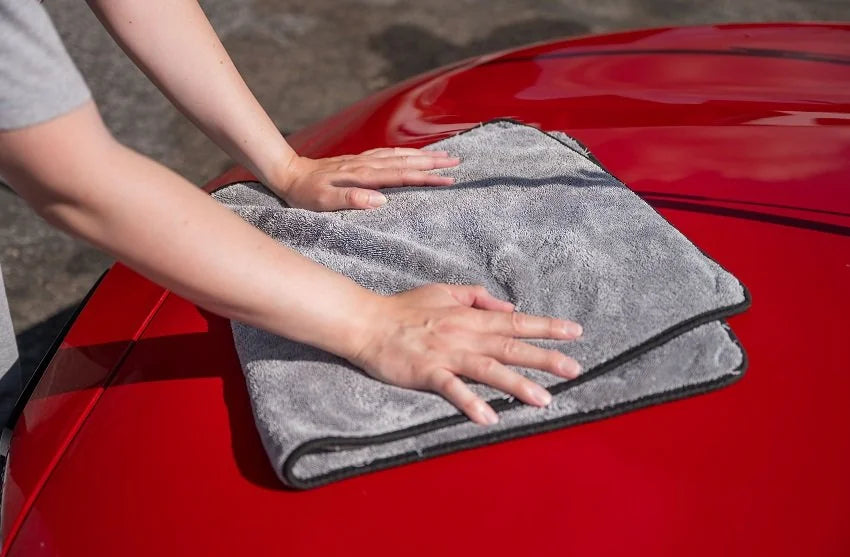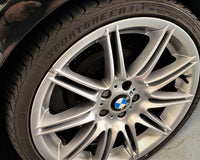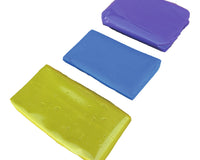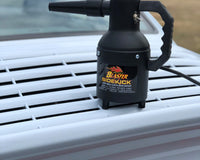Drying your car after a wash might seem like a minor post-cleaning step, but it plays a crucial role in preserving your vehicle's appearance and protecting its surfaces from potential damage. Let's delve deeper into understanding why adopting proper drying techniques is essential for maintaining your car's aesthetics and overall condition.
Prevent Water Spots and Mineral Deposits
Drying your car meticulously serves as a protective shield against the formation of water spots and mineral deposits. These unwelcome marks, caused by water evaporating and leaving behind minerals, can mar the once-gleaming paintwork, resulting in stubborn spots that diminish the car's overall appearance. The meticulous drying process ensures that all water residue is eliminated, mitigating the risk of these unsightly blemishes.
Moreover, by meticulously drying your vehicle's surface, you're safeguarding it against the adverse effects of hard water. The minerals present in hard water, if left to linger on the car's surface, can etch into the paint, leaving behind traces that diminish the vehicle's sheen. By adopting proper drying techniques, you effectively eliminate the likelihood of these minerals causing long-term damage.
Thoroughly drying your car after a wash also ensures that no water spots develop on windows and mirrors. Water droplets left to dry on these surfaces can lead to a cloudy or hazy appearance, affecting visibility. By diligently drying these areas, you ensure a clear and unobstructed view while driving, enhancing safety on the road.
Additionally, drying the vehicle's intricate parts, such as door handles and grilles, helps maintain their aesthetic appeal. Water residue trapped in these areas not only creates unattractive marks but, over time, can lead to corrosion or rusting. By employing meticulous drying practices, you safeguard these components, ensuring they retain their original luster.
Thorough drying also contributes to preventing mineral buildup on the vehicle's wheels. When water containing minerals evaporates from the wheels, it often leaves behind unsightly spots. Proper drying techniques help mitigate this, ensuring that the wheels maintain their shine and appearance, adding to the overall aesthetic appeal of the vehicle.
Minimize Swirl Marks and Scratches
Employing the right drying techniques significantly reduces the risk of swirl marks and scratches. Rough cloth or incorrect drying motions can cause surface abrasions, compromising the paintwork's integrity. Opting for soft, clean microfiber towels and adopting gentle patting motions greatly minimizes the likelihood of these unsightly marks.
Moreover, drying your car's surface thoroughly post-wash prevents the accumulation of dirt particles. These particles, when mixed with residual water, can turn into abrasive agents, causing minute scratches. Proper drying eliminates this risk, ensuring that the vehicle's paintwork remains smooth and unmarred.
Furthermore, correct drying practices minimize the potential of environmental contaminants adhering to the surface. When water dries naturally, it leaves behind residues that attract airborne pollutants. Proper drying eliminates these residues, reducing the chances of contaminants adhering to the surface and causing damage.
Effective drying also ensures that no residue remains in crevices or intricate body lines, minimizing the risk of dirt buildup. Dirt particles trapped in these areas, if not removed, can accumulate over time, resulting in scratches during subsequent washing or detailing sessions. Proper drying techniques eliminate this risk, maintaining the vehicle's pristine appearance.
Preserve Paintwork and Clear Coat
Properly drying your car is paramount for preserving the integrity of its paintwork and clear coat. Water, if allowed to linger, can gradually deteriorate the paint's protective layers, making it susceptible to fading, discoloration, or peeling. Effective drying techniques help safeguard these layers, preserving the vehicle's vibrant color and finish.
Additionally, thorough drying reduces the likelihood of water seeping into seams and edges. Water trapped in these areas can compromise the paint and clear coat, leading to bubbling or peeling. By diligently drying these critical zones, you prevent moisture-related damage, ensuring the longevity of the paintwork.
Furthermore, effective drying eliminates the risk of water-induced staining. Water droplets left to dry naturally can sometimes contain impurities that, when dried, leave behind stains. Properly drying the surface ensures the removal of these impurities, protecting the paintwork from potential staining and maintaining its pristine appearance.
Moreover, meticulous drying helps in maintaining the smoothness of the paint surface. Water, if allowed to evaporate naturally, can leave behind minute residues that compromise the paint's smoothness. By adopting proper drying techniques, you eliminate these residues, ensuring a consistently smooth and polished exterior.
Thoroughly drying the vehicle's surface also aids in protecting against water-induced damage in areas prone to wear, such as around door edges. Water pooling in these areas can lead to rust formation over time. By ensuring these areas are dry, you mitigate the risk of rusting and prolong the vehicle's life.
Maintain Shine and Gloss
Effectively drying your car post-wash is instrumental in preserving its shine and gloss. Water spots left on the surface can be visually unappealing, dulling the vehicle's overall appearance. By eliminating water spots through proper drying, you ensure that the car maintains its glossy finish, enhancing its aesthetic appeal.
Additionally, proper drying techniques help in achieving a streak-free finish. Water streaks or residue left on the surface can mar the vehicle's sheen. Meticulous drying eliminates these streaks, resulting in a flawlessly clean and glossy exterior.
Furthermore, drying aids in highlighting the paint's vibrancy and depth. A properly dried surface showcases the paint's true color and richness, allowing the vehicle to radiate a brilliant and eye-catching appearance.
Moreover, a well-dried surface contributes to an overall polished look. Water residue left to dry naturally can accumulate in nooks and crannies, compromising the vehicle's overall cleanliness. By meticulously drying these areas, you ensure an impeccably polished finish, elevating the car's overall aesthetic appeal.
Thorough drying also contributes to maintaining the shine of the vehicle's wheels and tires. Water spots or residue left on these surfaces can detract from their appearance. Proper drying ensures that these areas retain their shine, enhancing the vehicle's overall visual impact.
Professional Drying Techniques
Some more professional drying techniques being adopted by every expert in the field are:
Enhance Efficiency and Reduce Water Streaks
Employing adequate drying techniques efficiently removes excess water, reducing the chances of water streaks or trails forming on the vehicle's surface. This process optimizes the drying time and ensures a streak-free finish.
Protect Exterior Trim and Glass Surfaces
Thoroughly drying all exterior components, including trim and glass surfaces, prevents water residue from accumulating in nooks and crevices, potentially causing deterioration or water-related damage.
Avoid Corrosion and Rusting
Allowing water to pool in certain areas, such as door jambs or seams, can lead to corrosion and rust over time. Drying these critical areas thoroughly helps prevent long-term damage caused by water accumulation.
How to Properly Dry Your Car
To effectively dry your vehicle, start by using a clean, high-quality microfiber drying towel. Begin at the top and work your way down, gently patting and blotting the surface to absorb moisture without applying excessive pressure.
Consider Using a Blower or Air Dryer
Utilizing a blower or air dryer to remove excess water from hard-to-reach areas, such as side mirrors or grilles, aids in achieving a comprehensive drying process without causing scratches.
Avoid Direct Sunlight and High Temperatures
Drying your car in direct sunlight or high temperatures accelerates water evaporation, potentially leading to premature drying and the formation of water spots. Opt for shaded areas or cooler environments for a more controlled drying process.
Use Proper Towel Care and Maintenance
Regularly wash and maintain your microfiber towels to ensure they remain clean and free from contaminants that could potentially cause scratches during the drying process.

The Role of Quick Detailing Sprays in Drying
Quick detailing sprays can serve as an aid in the drying process, providing lubrication and added shine while removing any remaining water spots or streaks.
Tailor Techniques for Different Surfaces
Adapt drying techniques based on different surface materials. For delicate surfaces like matte paint or chrome, opt for specialized drying methods to prevent damage.
DIY Water Repellent Coatings for Enhanced Drying
Consider applying DIY water repellent coatings to your car's exterior surfaces. These coatings aid in water runoff, facilitating easier drying and reducing the likelihood of water spots.
Importance of Interior Drying
Don't overlook drying the car's interior surfaces. Removing excess moisture from interior components helps prevent mold and mildew growth while preserving the interior's aesthetics.
Professional Drying Services: Are They Worth It?
Professional car wash facilities often offer specialized drying services, such as air blowers and detailing techniques, ensuring a meticulous and thorough drying process. Consider these services for comprehensive car care.
Environmental Impact and Water Conservation
Efficient drying practices contribute to water conservation efforts by reducing the need for excessive rinsing and minimizing water wastage during the car washing process.
Conclusion: Prioritizing Proper Drying for Car Care
In conclusion, mastering proper drying techniques is an integral part of maintaining your car's appearance, protecting its surfaces, and prolonging its overall lifespan. Adopting meticulous drying habits enhances the car washing process, contributing to a pristine finish and long-term preservation of your vehicle.




